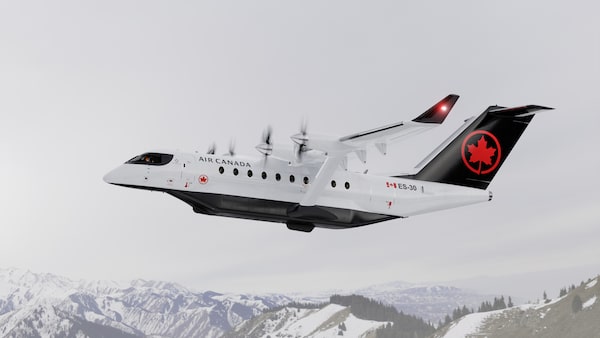
Air Canada says it will buy 30 ES-30 electric-hybrid airplanes being developed by Sweden’s Heart Aerospace.Supplied
Air Canada says it will buy 30 electric-hybrid airplanes and invest US$5-million in the developer, Sweden’s Heart Aerospace, as it works to reach the airline’s goal of net-zero emissions by 2050.
Air Canada AC-T said Thursday that the 30-passenger, four-motor ES-30 aircraft, which will also have a generator powered by fuel, are expected to be flying regional routes by 2028.
The aircraft, still under development, is expected to have a range of up to 200 kilometres, fully loaded and flying on a lithium-ion battery. Flights can reach 400 km using the generator and 800 km with reduced capacity of 25 passengers. Charging time for the battery will be about 30 to 50 minutes, the companies said in a joint press release.
The ES-30 will be quieter and more reliable than the turboprop aircraft flown regionally, Air Canada said, with a smaller environmental footprint.
Global aviation produces 1.04 billion tonnes of carbon dioxide, a greenhouse gas that causes climate change, accounting for 2.5 per cent of all emissions in 2018, according to the International Energy Agency.
“Air Canada has taken a leadership position in the industry to address climate change,” said Michael Rousseau, chief executive officer of Air Canada. “The introduction into our fleet of the ES-30 electric regional aircraft from Heart Aerospace will be a step forward to our goal of net-zero emissions by 2050.”
The head of privately held Heart Aerospace called Air Canada an important partner. “The company has one of the world’s largest networks operated by regional turboprops, and it is also a progressive, future-leaning company,” said Anders Forslund, founder and CEO. “With the ES-30, we can start cutting emissions from air travel well before the end of this decade.”
The companies did not announce a purchase price for the planes, which will be made in Gothenburg, Sweden.
In a separate statement, Heart said it has orders for 200 of the aircraft, with options for another 100, and 96 letters of intent to purchase. United Airlines UAL-Q and Mesa Air Group MESA-Q are among the buyers, and are also investors in Heart. Swedish aerospace and defence company Saab AB is investing US$5-billion in the company as well, Heart said on Thursday.
Jacques Roy, a logistics professor at HEC Montréal, said the small size and short range of the aircraft are unusual for Air Canada, given the airline is moving away from the short-haul market. But he said the airline is likely trying out the nascent technology, with a plan to use larger planes as they develop.
“It’s reasonable they would start with smaller [aircraft],” Prof. Roy said by phone. “To them, it’s a way to experience the new technology.”
He noted that the venture is a “serious” one that involves other large players working to reduce harmful emissions from air travel. “It’s a trend for the future,” Prof. Roy said. “The industry has to go down that path eventually.”
The International Energy Agency said in a 2021 report that without a breakthrough in battery technologies, electric aircraft will be restricted to small sizes and distances of less than 1,000 km until 2050 “at best.” Hybrid electric or turboelectric designs could reach 3,000 km.
“To accelerate to speeds that generate the lift needed to take off, planes require fuels that have high energy densities,” the IEA said. “Another challenge is that batteries, unlike fuel tanks, do not get lighter during the flight.”
The agency said short-haul flights are a small part of the CO2 problem, and therefore battery-powered planes will reduce overall emissions by only a small amount.
European aviation giant Airbus SE EADSY is developing three types of zero-emissions commercial aircraft powered by engines that run on liquid hydrogen burned in gas turbines and hydrogen fuel cells by 2035. The turbofan version will fly more than 200 people a distance of 3,500 km, Airbus said.
The IEA said hydrogen requires “vast amounts” of low-carbon energy to produce and requires changes in airport infrastructure to store and deliver.
Over the next decade, the IEA said, the main solution to reducing aviation emissions will be the use of sustainable aviation fuel, made from oil derived from crops and animals. However, such fuel accounts for just 0.1 per cent of jet fuel consumed, with limited production and higher prices.
Air Canada has added more fuel-efficient aircraft in recent years, including the Boeing 737 Max and Airbus A220 and A321, as it works to reduce greenhouse gases from flying by 20 per cent by 2030, and achieve net zero emissions by 2050. The airline has retired 79 older, inefficient aircraft, including 25 Boeing 767s.
“Sustainability is very important for Air Canada and, I think, the industry overall,” said Amos Kazzaz, Air Canada’s chief financial officer, at an investors’ conference in Laguna Beach, Calif., on Thursday.
Your time is valuable. Have the Top Business Headlines newsletter conveniently delivered to your inbox in the morning or evening. Sign up today.